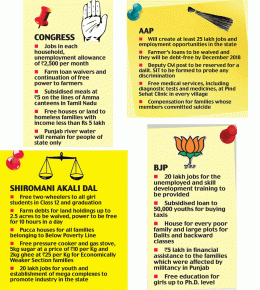The race to be Sardar of Punjab

The westerly winds, called ‘pacchhon’ that blow through Punjab in Northeastern India this time of the year, normally signal a change of seasons.
This time those winds are also heralding a change in the political landscape of Punjab, the homeland of hundreds of thousands of Indo-Canadians often referred to as NRI’s or Non-Resident Indians.
Hundreds of them have arrived from various cities in "Kanneda" (Canada), reported local media this week.
In the southern belt of Punjab, known as the Malwa area, white jeeps with Canadian, Australian, British and American flags, are traversing the countryside bearing Punjabis, encouraging people to vote.
NRI volunteers purposely dress differently. They wear their suits and ties even when they are campaigning in rural Punjab. They want to be identified as being different from the party they support. They want their 'pind' (village) to know that they have left their successful businesses or careers for a short break because they want to be part of the 'great change' that is going to come to Punjab, one news report said.
Punjab is on the cusp of a history-making assembly election. Since 1947, the two traditional parties, the Shiromani Akali Dal (SAD) and Congress, have dominated the electoral landscape and taken turns to rule the border state, seven times each. In 2012, the SAD combined forces with the BJP to rule Punjab.
This time, however, a third political entity the Aam Aadmi Party (AAP) has disturbed the mould providing Punjab with a potent alternative force in the power sweepstakes.
The high-octane battle of the ballot for the Punjab Assembly polls begins Feb 4 with 1,146 candidates fighting for 117 constituencies.
As the NRI-brigade traverses Punjab to showcase why their homeland needs western transparency in governance, local politicians are making a mockery of democracy by offering freebies like rations, jobs and loans to lure voters.
The Congress led by Captain Amarinder Singh has promised free travel for students, police officials, ex-servicemen, paramilitary force personnel and senior citizens in the state transport buses.
It has also promised subsidized food canteens for the poor which will provide a meal at Rs5 throughout the state.
THE SAD-BJB combine led by incumbent Deputy Chief Minister Sukhbir Singh Badal has promised vocational training to hundreds of thousands of youth by opening 2,500 skill development centres across the state, besides providing houses to the homeless, free pressure cookers, gas stoves and free education for girls up to PHD levels.
Arvind Kejriwal’s AAP, which has mobilized the most support from NRI’s with its anti-corruption campaign, is offering free medical and diagnostic tests in every village, a waiver of loans to farmers and compensation to families whose members have committed suicide.
All the main players have described each other’s manifestos 'misleading and meaningless'.
The fight for Punjab, which has traditionally been waged in the villages has also shifted to high-tech war-rooms
With a large share (around 35-40%) of young voters in the state being internet users, the war rooms have come to a consensus that the next Sardar of Punjab will be chosen online and are devising blueprints to lure the youth vote.
The war rooms are not only being used as a voter outreach tool but also to manage campaigns and media outreach.
This is done through social media as well as conventional media like print, broadcast and television.
Congress, which was the first to set up its war room in the state with a force of 450 people in Mohali, has taken the lead in gauging the mood of the voters and launching campaigns to swing votes to its side.
The SAD, which is considered a traditional party and had been solely dependent on direct contact with voters till 2014 has also set up a war room, after it realised how AAP punched holes into its vote bank using digital media campaigns.
It has employed nearly 80 people to manage its war room.
Undeterred, the AAP's Punjab Facebook page boasts 865,000 'likes.
Ironically, the young voters have to choose between ageing leaders who are the chief ministerial faces of two parties — the SAD and the Congress.
Chief Minister Parkash Singh Badal is 89 years old. His Congress rival, Amarinder Singh, claims that Badal is actually 94 years old, while he himself will turn 75 in March.
The AAP is yet to project its chief ministerial candidate
As the final countdown to the polls begin this week in Punjab, perhaps the only thing that is certain is that great change is coming to Punjab.









